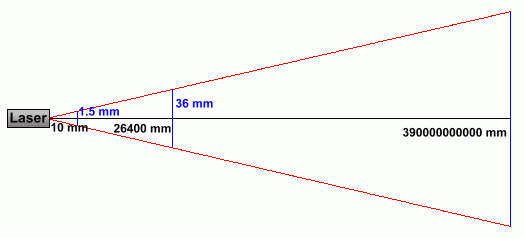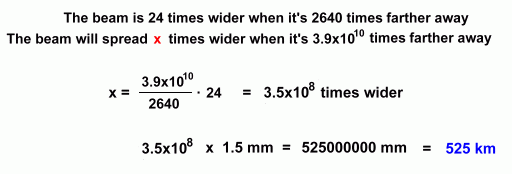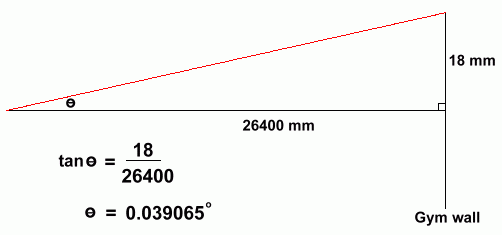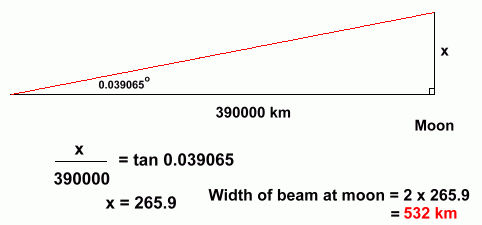 We were curious to see how much spread there would be using a simple laser pointer aimed at the moon. In order to figure it out an answer to this question, we first aimed the pointer at a wall across the gymnasium, a distance of 26.4 metres, or 26,400 mm. Next we set up this diagram: (The spread is exaggerated in order to make the diagram clearer) 
390000000000 mm is the distance to the moon, in millimetres. We measured the width of the light beam coming out of the laser: - At a distance of 10 mm from the lens, and found it to be 1.5 mm (+/- 0.1 mm) across. - At the measured distance of 26400 mm (+/- 10 mm) across the gym, the width of the beam had grown to 36 mm (+/- 1 mm). In other words, the width of the beam had increased by a factor of 24 times (36 divided by 1.5) when the distance had grown by a factor of 2640 times (26,400 divided by 10). We now used a simple ratio problem to solve for the width of the beam at the moon, which is 390,000 km away. This distance is 3.9 x 1011 mm, or 3.9 x 1010 times as far as the first measurement 10 mm from the lens. 
This means that the laser pointer would cover a width of 525 km if shone on the moon. Allowing for the +/- error range on our measurements, and recalculating to get a lower and upper possible answer, we discovered that the solution could range between about 480 to 590 km. So a reasonable conclusion might be that a laser pointer beam will spread out to cover a width of somewhere around 500 km when it reaches the moon. We then did the calculation a different way to check the result. Using trigonometry, we found the half-angle of spread for the beam: 
Then we used this angle to calculate the width of the beam at the moon: 
Once again allowing for possible error in the measurements, we recalculated using the minimum and maximum possible values to determine that the width of the beam is somewhere between 517 and 546 km. This agrees well with our first result. It seems reasonable to conclude that a laser pointer beam will spread out to cover a width of somewhere around 500 km when it reaches the moon. If you compare this to the mere 1.6 km spread of a laboratory laser, it tells you that the light coming out of an inexpensive pointer laser isn't very coherent or monochromatic compared to a more expensive laser, although it still is a lot more so than an ordinary flashlight beam. Of course, the intensity of the laser pointer is also very small, so that the number of laser light photons impacting the moon would be so widely spaced out as to make the light undetectable. |